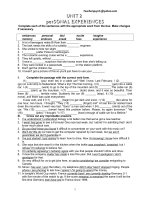UNIT 2 WAYS OF SOCIALIZING MCQs 2
Bạn đang xem bản rút gọn của tài liệu. Xem và tải ngay bản đầy đủ của tài liệu tại đây (79.24 KB, 3 trang )
<span class='text_page_counter'>(1)</span>TEST 2 Choose the word which is stressed differently from the rest. 1. a. social1 b. meter c. notice1 d. begin2 2. a. whistle1 b. table1 c. someone1 d. receive2 3. a. discuss2 b. waving c. airport1 d. often1 4. a. sentence1 b. pointing1 c. verbal1 d. attract2 5. a. problem1 b. minute1 c. suppose2 d. dinner Choose a, b, c, or d that best completes each unfinished sentence, substitutes the underlined part, or has a close meaning to the original one. 6. The boy waved his hands to his mother, who was standing at the school gate, to _______ her attention. a. attract b. pull c. follow d. tempt 7. If something _______ your attention or your eye, you notice it or become interested in it. a. pays b. allow c. catches d. wave 8. When you are in a restaurant, you can raise your hand slightly to show that you need assistance. a. bill b. menu c. help d. food 9. After a _______ hesitation, she began to speak with such a convincing voice. a. rude b. slight c. small d. impolite 10. He is one of the most _______ bosses I have ever worked with. He behaves rudely to not only me but also others in the staff. a. thoughtful b. impolite c. attentive d. communicative 11. In many cultures, people signify their agreement by _______ their head. a. turning b. raising c. pointing d. nodding 12. There was a _______ tremble in her voice, which showed that she was very nervous at that time. a. slight b. slighted c. slightly d. slightness 13. If a boss wants to have a well-qualified staff, he should have to pay his employees _______. a. appropriate b. appropriately c. appropriation d. appropriating 14. Mrs. Pike was so angry that she made a _______ gesture at the driver. a. rude b. rudeness c. rudely d. rudest 15. _______ nonverbal language is _______ important aspect of interpersonal communication. a. The / Ø b. A / the c. The / a d. Ø / an 16. Balzer, _______ linguistic researcher, reported that approximately 75% of classroom management behavior was nonverbal. a. a b. an c. the d. Ø 17. I have never seen such a beautiful dress _______ you before. a. of b. on c. for d. in 18. Small children are often told that it is rude to point _______ other people. a. on b. to c. at d. for 19. - You look great in this new dress. - ________. a. With pleasure b. Not at all c. I am glad you like it d. Do not say anything about it 20. Suppose you want to go out during a lecture, what should you do? a. As b. If c. Though d. When 21. Peter said that he had lived in London four years _______. a. ago b. before c. later d. then 22. The guest told the host that _______. a. I must go now b. he must go now c. he had to go now d. he had to go then 23. The teacher told Joe _______. a. to stop talking b. stop talking c. stops talking d. stopped talking 24. She said she _______. a. was very tired last night b. was very tired the night before c. had been very tired last night d. had been very tired the night before 25. Emily said that her teacher _______ to London _______. a. will go / tomorrow b. went / tomorrow c. would go / the next day d. had gone / the next day 26. She told the boys _______ on the grass..
<span class='text_page_counter'>(2)</span> a. do not play b. did not play c. not playing d. not to play 27. She asked _______. a. where was her umbrella b. where her umbrella was c. where were her umbrella d. where her umbrella were 28. Jason asked me _______ me the book the day before. a. if who gave b. if who has given c. who had given d. that who had given 29. Robert said that his father _______ to Dallas the year before. a. goes b. went c. has gone d. had gone 30. He wanted to know _______ shopping during the previous morning. a. if we had been going b. that if we had been going c. we were going d. that we were going Choose the sentence which has the closest meaning to the original one 31. "How beautiful is the dress you have just bought!" Peter said to Mary. a. Peter promised to buy Mary a beautiful dress. b. Peter said thanks to Mary for her beautiful dress. c. Peter complimented Mary on her beautiful dress. d. Peter asked Mary how she had just bought her beautiful dress. 32. She raised her hand high so that she could attract her teacher's attention. a. Because her teacher attracted her, she raised her hand high. b. To attract her teacher's attention, she raised her hand high. c. Though she raised her hand high, she could not attract her teacher's attention. d. She had such a high raising of hand that she failed to attract her teacher's attention. 33. "Hello, Mary!" Peter said. ' a. Peter said hello Mary. b. Peter said Mary hello. c. Peter told Mary hello d. Peter greeted Mary. 34. Julie and Anne had not met each other before the party. a. Julie and Anne got acquainted when they were at the party. b. The party prevented Julie and Anne from meeting each other. c. The party was the place where Julie and Anne could not meet each other. d. Julie and Anne used to meet each other for the party. 35. "Why don't you ask the teacher for help?" Peter asked me. a. Peter advised me to ask the teacher for help. b. Peter recommended me not to ask the teacher for help. , c. Peter told me the reason why I did not ask the teacher for help. d. Peter suggested that he should ask the teacher for help. Read the passage carefully and choose the correct answer. Movements and gestures by the hands, arms, legs, and other parts' of the body and face are the most pervasive types of nonverbal messages and the most difficult to control. 'It is estimated that there are over 200.000 physical signs capable of stimulating meaning in another person. For example, there are 23 distinct eyebrow movements, each capable of stimulating a different meaning. Humans express attitudes toward themselves and vividly through body movements and postures. Body movements express true messages about feelings that cannot be masked. Because such avenues of communication are visual, they travel much farther than spoken words and are unaffected by the presence of noise that interrupt, or cancels out speech. People communicate by the way they walk, stand, and sit. We tend to be more relaxed with friends or when addressing those of lower status. Body orientation also indicates status or liking of the other individual. More direct orientation is related to a more positive attitude. Body movements and postures alone have no exact meaning, but they can greatly support or reject the spoken word. If these two means of communication are dichotomized and contradict each other, some result will be a disordered image and most often the nonverbal will dominate. 36. Which part of body is not used to send body message? a. faces b. legs c. hands d. stomachs 37. Face gestures ________. a. can help us control our feelings b. are the most difficult to control c. cannot express our feelings d. do not include eye brow moments 38. Body communication is ________..
<span class='text_page_counter'>(3)</span> a. visual b. verbal c. very few d. uncommon 39. According to the text, body movements cannot express ________. a. feelings b. status c. attitudes d. desires 40. Nonverbal communication ________. a. may be interrupted by noise b. has no relation to verbal communication c. dominates words d. is less common than verbal communication Fill in each numbered blank with one suitable word or phrase. In the western customs (41) _____ hands is the customary form of greeting, but in China a nod of the head or (42) _____ bow is sufficient. Hugging and kissing when greeting are uncommon. Business cards are often (43) _____ and yours should be printed in your own language and in Chinese. Also, it is more respectful to present your card or a gift or -any other article using (44) _____ hands. The Chinese are (45) _____ applauders. You may be greeted with group clapping, even by small children. When a person is applauded in this practice it is the custom for that person to return the applause or a "thank you." When walking in public places, direct eye (46) _____ .and staring is uncommon in the larger cities, especially in those areas accustomed to foreign visitors. (47) _____, in smaller communities, visitors may be the subject of much curiosity and therefore you may notice some stares. (48) _____ speaking, the Chinese are not a touch-oriented society, especially true for visitors. So, avoid (49) _____ or any prolonged form of body contact. Public displays of affection are very rare. On the other hand, you may note people of the same sex walking hand-in-hand, which is simply a gesture of friendship. Do not worry about a bit of pushing and shoving in stores or when groups board public buses or trains. In this case, (50) _____ are neither offered or expected. The Chinese will stand much closer than Westerners. 41. a. taking b. shaking c. grasping d. hugging 42. a. small b. bit c. slight d. light 43. a. exchanged b. changed c. transferred d. converted 44. a. pair b. couple c. double d. both 45. a. enthusiast b. enthusiastic c. enthusiasm d. enthusiastically 46. a. contact b. look c. stare d. watch 47. a. Moreover b. Furthermore c. However d. Whatever 48. a. Generally b. Successfully c. Fortunately d. Expectedly 49. a. touch b. to touch c. touched d. touching 50. a. Contacts b. Apologies c. Gestures d. Saying goodbye.
<span class='text_page_counter'>(4)</span>






